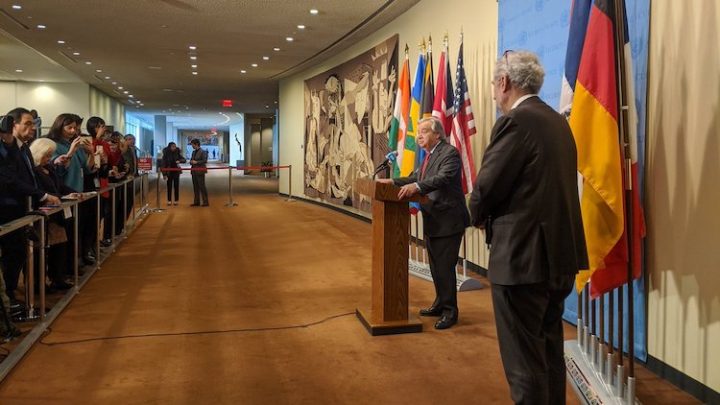By Ramesh Jaura
“Stop escalation. Exercise maximum restraint. Re-start dialogue. Renew international cooperation.” This is the four-point message of UN Secretary-General António Guterres spelling out what needs to happen now, in capitals across the world, to de-escalate geopolitical tensions, which he described as being “at their highest level this century” as the new decade dawns.
The New Year has begun with our world in turmoil. We are living in dangerous times”, said the UN chief on January 6, noting that turbulence is only escalating. “Even nuclear non-proliferation can no longer be taken for granted,” he added, without specifically referencing the events of recent days following the targeted killing by a United States drone, of Iran’s most influential general, Qasem Soleimani, in Iraq on January 3.
Iran has vowed to avenge the killing of the elite Quds Force commander, and on January 5 it signified it would no longer be bound by the restrictions on its nuclear programme, outlined in the 2015 deal known as the Joint Comprehensive Plan of Action, or JCPOA. The deal was debated in the Security Council just last month.
Mr. Guterres on January 1 also expressed his deep concern at the announcement by the Democratic People’s Republic of Korea (DPRK), commonly known as North Korea, that it was ending its self-imposed moratorium on nuclear missile testing.
The Iraqi parliament passed on January 5 a non-binding resolution calling for U.S. troops to leave the country, in a clear response to the killing of the Iranian general on their soil. In response, President Trump has threatened Iraq with sanctions if forced to withdraw its forces, and also threatened on Twitter, to destroy multiple sites of “cultural” significance within Iran, if there are reprisal attacks against Americans.
As UN News reported, Mr. Guterres told the noon stakeout for correspondents at UN Headquarters in New York on January 6, that a “cauldron of tensions is leading more and more countries to take unpredicted decisions with unpredictable consequences and a profound risk of miscalculation. At the same time, we see trade and technological conflicts that fracture world markets, undermine growth and widen inequalities,” he added.
Besides, said the UN chief, “our planet is on fire. The climate crisis rages on. In many parts of the world, we see many people frustrated and angry. We see increased social unrest and growing extremism, nationalism and radicalization, with a dangerous advance of terrorism, notably in Africa”.
He said it was clear that “this situation cannot go on. I have been following the recent rise in global tensions with great concern. I am in constant contact with leading officials around the world”.
The current tensions across the Middle East and Gulf region and their potential implications for cultural heritage sites were the focus of a meeting on January 6 between the head of the UN’s cultural agency, UNESCO, and a senior diplomat from Iran.
UNESCO Director-General Audrey Azoulay and Iranian Ambassador to the UN agency, Ahmad Jalali, met in Paris against a background of mounting threats between his country and the United States.
Ms Azoulay used the meeting to stress the universality of cultural and natural heritage in promoting peace and dialogue between peoples, and which the international community has a duty to protect and preserve for future generations.
She pointed to two UN treaties on protecting cultural heritage, including during conflict, which both countries have ratified. The 1954 Convention for the Protection of Cultural Property in the Event of Armed Conflict is the first international treaty to address this subject. The second treaty is the 1972 Convention Concerning the Protection of the World Cultural and Natural Heritage.
The 1954 Convention was adopted in the wake of the widespread destruction of cultural heritage during the Second World War. Examples of cultural heritage include monuments and archaeological sites, but also architecture, works of art, books, scientific collections, and other objects of artistic, historical or archaeological interest. Under the treaty, countries pledge to spare these items from possible armed conflict through protective measures and even sanctions.
UNESCO explained that threats can come from fighting but also any resulting occupation.
“As cultural property reflects the life, history and identity of the community, its preservation helps to rebuild a broken community, re-establish its identity, and link its past with its present and future. In addition, the cultural property of any people contributes to the cultural heritage of humankind. Thus, loss of or damage to such property impoverishes humankind,” according to information on the UNESCO website.
The most significant feature of the 1972 Convention is that it links “the concepts of nature conservation and the preservation of cultural properties” and the need to preserve balance between the two. It stipulates, among others, that each State Party “undertakes not to take any deliberate measures which might damage directly or indirectly the cultural and natural heritage […] situated on the territory of other States Parties to this Convention.”
The UNESCO Director-General also recalled the terms of United Nations Security Council Resolution 2347 adopted unanimously in 2017, which condemns acts of destruction of cultural heritage. Furthermore, as UNESCO reported, Ms Azoulay stressed the universality of cultural and natural heritage as vectors of peace and dialogue between peoples, which the international community has a duty to protect and preserve for future generations. [IDN-InDepthNews – 07 January 2020]
Photo: UN chief Guterres told the noon stakeout for correspondents at UN Headquarters in New York on January 6, that a “cauldron of tensions” could lead countries to unpredicted decisions with unpredictable consequences. Credit: United Nations.










